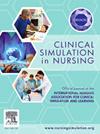Feasibility and acceptability of incorporating artificial intelligence into simulation education
IF 2.5
3区 医学
Q1 NURSING
引用次数: 0
Abstract
Background
Simulation serves as one opportunity for students to engage with AI and enhance their learning experience. This study examined the feasibility and acceptability of incorporating AI into simulation education.
Methods
Students participated in a high-fidelity simulation scenario with an AI-enabled mannequin to learn how to effectively respond to an opioid-involved overdose. Participants completed acceptability/ feasibility measures, and surveys on knowledge and attitudes towards responding to an overdose.
Results
Participants’ attitudes towards (p = 0.002) and knowledge (p = 0.004) about responding significantly increased and remained high up to a month later and found the AI-enabled mannequin to be acceptable and feasible to engage with in the simulation environment.
Conclusions
AI-enabled mannequins were found to be acceptable and feasible to incorporate into simulation nursing education to learn how to respond to an opioid-involved overdose. These findings highlight the need for additional research examining the utility of AI in simulation scenarios to improve learners’ outcomes.
将人工智能纳入模拟教育的可行性和可接受性
背景模拟为学生提供了一个接触人工智能并增强学习体验的机会。本研究考察了将人工智能纳入模拟教育的可行性和可接受性。方法:学生们参与了一个具有人工智能功能的人体模型的高保真模拟场景,以学习如何有效地应对阿片类药物过量。参与者完成了可接受性/可行性测试,以及对药物过量反应的知识和态度的调查。结果参与者对响应的态度(p = 0.002)和知识(p = 0.004)显著增加,并在一个月后保持高水平,并且发现人工智能启用的人体模型在模拟环境中是可接受和可行的。结论人工智能人体模型被认为是可接受和可行的,可以纳入模拟护理教育,以学习如何应对阿片类药物过量。这些发现强调了需要进一步研究人工智能在模拟场景中的效用,以提高学习者的成绩。
本文章由计算机程序翻译,如有差异,请以英文原文为准。
求助全文
约1分钟内获得全文
求助全文
来源期刊

Clinical Simulation in Nursing
NURSING-
CiteScore
5.50
自引率
15.40%
发文量
107
期刊介绍:
Clinical Simulation in Nursing is an international, peer reviewed journal published online monthly. Clinical Simulation in Nursing is the official journal of the International Nursing Association for Clinical Simulation & Learning (INACSL) and reflects its mission to advance the science of healthcare simulation.
We will review and accept articles from other health provider disciplines, if they are determined to be of interest to our readership. The journal accepts manuscripts meeting one or more of the following criteria:
Research articles and literature reviews (e.g. systematic, scoping, umbrella, integrative, etc.) about simulation
Innovative teaching/learning strategies using simulation
Articles updating guidelines, regulations, and legislative policies that impact simulation
Leadership for simulation
Simulation operations
Clinical and academic uses of simulation.
 求助内容:
求助内容: 应助结果提醒方式:
应助结果提醒方式:


